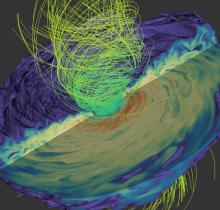
Description
This award supports research in relativity and relativistic astrophysics and it addresses the priority areas of NSF's "Windows on the Universe" Big Idea. The recent observations of a binary neutron star merger using both gravitational wave interferometers and the full spectrum of electromagnetic telescopes has initiated the age of multimessenger astronomy and astrophysics. The rapidly increasing rate of new GW detections by LIGO, VIRGO, and other upcoming similar interferometers and major astronomical facilities is expected to bring an unprecedented wealth of observational evidence from these sources in the near future. This award will fund a collaborative research effort at the Rochester Institute of Technology and the Johns Hopkins University into the latter stages of neutron star mergers, in particular long-lived hypermassive neutron stars that collapse to black holes and stable neutron stars. The effort also includes development of new computational tools required for these calculations. Particular attention will be paid to the roles of the equation of state and total mass as determinants of final properties such as magnetic fields. Magnetic fields underly much of what happens because they support both accretion and jets.
Simulations of a wide range of astrophysical events, including strong sources of both electromagnetic and gravitational wave signals, will require numerical tools that can handle an increasingly wide range of microphysical treatments, characteristic scales, and levels of complexity. On the other hand, many astrophysical systems exhibit approximate symmetries that can be leveraged to reduce the total computational cost. By choosing coordinate topologies that mirror the approximate symmetries, or multiple coordinate patches, one can obtain higher simulation accuracies at lower computational costs. Spherical polar grids are optimally suited for a host of applications in relativistic astrophysics. However, the often severe Courant stability limitation of these methods have made them prohibitively expensive. This project is to develop new coding infrastructures to overcome these limitations and apply them to perform highly-accurate, but also very fast simulations of hypermassive neutron star remnants. On the other hand, multipatch method, while computational more complex than single spherical patches, are ideal for simulations of jets around these compact objects. In addition to developing new algorithms, this award will be used train a postdoc and a graduate student in highly-parallelized computing. It will also provide material for educating students in multimessenger astronomy and high-performance computing, and enhance public outreach through a variety of channels, including both an REU program in multimessenger astronomy and a summer program giving underrepresented minority undergraduates experience in physics research. Further educational benefits will accrue through improvements in undergraduate science education. Scientific visualizations from the proposed simulations will be used as a vehicle for public outreach events on science and computing through annual community-wide public exhibits. There will also be benefits to the broader scientific community: both the new simulation tools and the output data sets will be made public.
This award reflects NSF's statutory mission and has been deemed worthy of support through evaluation using the Foundation's intellectual merit and broader impacts review criteria.